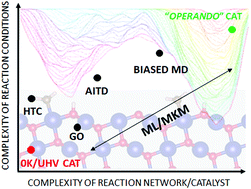当前位置:
X-MOL 学术
›
Chem. Soc. Rev.
›
论文详情
Our official English website, www.x-mol.net, welcomes your
feedback! (Note: you will need to create a separate account there.)
Towards operando computational modeling in heterogeneous catalysis
Chemical Society Reviews ( IF 40.4 ) Pub Date : 2018-09-11 00:00:00 , DOI: 10.1039/c8cs00398j Lukáš Grajciar 1 , Christopher J Heard , Anton A Bondarenko , Mikhail V Polynski , Jittima Meeprasert , Evgeny A Pidko , Petr Nachtigall
Chemical Society Reviews ( IF 40.4 ) Pub Date : 2018-09-11 00:00:00 , DOI: 10.1039/c8cs00398j Lukáš Grajciar 1 , Christopher J Heard , Anton A Bondarenko , Mikhail V Polynski , Jittima Meeprasert , Evgeny A Pidko , Petr Nachtigall
Affiliation

|
An increased synergy between experimental and theoretical investigations in heterogeneous catalysis has become apparent during the last decade. Experimental work has extended from ultra-high vacuum and low temperature towards operando conditions. These developments have motivated the computational community to move from standard descriptive computational models, based on inspection of the potential energy surface at 0 K and low reactant concentrations (0 K/UHV model), to more realistic conditions. The transition from 0 K/UHV to operando models has been backed by significant developments in computer hardware and software over the past few decades. New methodological developments, designed to overcome part of the gap between 0 K/UHV and operando conditions, include (i) global optimization techniques, (ii) ab initio constrained thermodynamics, (iii) biased molecular dynamics, (iv) microkinetic models of reaction networks and (v) machine learning approaches. The importance of the transition is highlighted by discussing how the molecular level picture of catalytic sites and the associated reaction mechanisms changes when the chemical environment, pressure and temperature effects are correctly accounted for in molecular simulations. It is the purpose of this review to discuss each method on an equal footing, and to draw connections between methods, particularly where they may be applied in combination.
中文翻译:

走向多相催化中的操作计算模型
在过去的十年中,多相催化的实验和理论研究之间的协同作用日益明显。实验工作已从超高真空和低温扩展到操作条件。这些发展促使计算界从基于 0 K 和低反应物浓度(0 K/UHV 模型)势能表面检查的标准描述性计算模型转向更现实的条件。从 0 K/UHV 到操作模型的转变得到了过去几十年计算机硬件和软件重大发展的支持。新方法的发展旨在克服 0 K/UHV 和操作条件之间的部分差距,包括 (i) 全局优化技术,(ii)从头开始约束热力学,(iii) 偏向分子动力学,(iv) 反应的微动力学模型网络和(v)机器学习方法。通过讨论当在分子模拟中正确考虑化学环境、压力和温度影响时,催化位点的分子水平图和相关反应机制如何变化,强调了转变的重要性。本次综述的目的是在平等的基础上讨论每种方法,并建立方法之间的联系,特别是在它们可以组合应用的情况下。
更新日期:2018-09-11
中文翻译:

走向多相催化中的操作计算模型
在过去的十年中,多相催化的实验和理论研究之间的协同作用日益明显。实验工作已从超高真空和低温扩展到操作条件。这些发展促使计算界从基于 0 K 和低反应物浓度(0 K/UHV 模型)势能表面检查的标准描述性计算模型转向更现实的条件。从 0 K/UHV 到操作模型的转变得到了过去几十年计算机硬件和软件重大发展的支持。新方法的发展旨在克服 0 K/UHV 和操作条件之间的部分差距,包括 (i) 全局优化技术,(ii)从头开始约束热力学,(iii) 偏向分子动力学,(iv) 反应的微动力学模型网络和(v)机器学习方法。通过讨论当在分子模拟中正确考虑化学环境、压力和温度影响时,催化位点的分子水平图和相关反应机制如何变化,强调了转变的重要性。本次综述的目的是在平等的基础上讨论每种方法,并建立方法之间的联系,特别是在它们可以组合应用的情况下。









































 京公网安备 11010802027423号
京公网安备 11010802027423号